Learning how to read tires is a valuable skill to have on hand for a multitude of scenarios. Whether you are in the market for new tires, checking their recommended tire pressure, or making sure they aren’t expired, there are a whole bunch of numbers and codes to be aware of.

Knowing the most common codes on tires, such as date codes and sizes, can also help you negotiate when buying a used car.
Table of Contents
Reading the Date Code on Tires
Even if your tires don’t have a ton of mileage on them, or still have tread, it is still a good idea to monitor their age. After seven years, many companies will no longer rotate and balance your tires, due to the degradation of rubber becoming a safety issue.
Most tire manufacturer warranties cover their tires for four years from the date of purchase or five years from the week the tires were manufactured. If you purchase new tires that were manufactured exactly two years ago they will be covered for a total of six years, four years from the date of purchase, as long as you have your receipt as proof of purchase.
If you don’t have a receipt or proof of purchase, your tire warranty coverage will end five years from the week the tire was produced. In this example, this would result in the tire manufacturer’s warranty coverage ending only three years from the date of purchase.
Since 2000, the week and year the tire was produced has been provided by the last four digits of the Tire Identification Number with the 2 digits being used to identify the week immediately preceding the 2 digits used to identify the year.
Tires Manufactured After 2000
All tires manufactured after the year 2000 use the current Tire Identification Number format:
DOT U2LL LMLR 5107
The last four digits provide the week and the year manufactured in a 4-digit code.
DOT U2LL LMLR 5107 Manufactured during the 51st week of the year.
DOT U2LL LMLR 5107 Manufactured during 2007.
While the entire Tire Identification Number is required to be branded onto one sidewall of every tire, current regulations also require that DOT and the first digits of the Tire Identification Number must also be branded onto the opposite sidewall. Therefore, it is possible to see a Tire Identification Number that appears incomplete and requires looking at the tire’s other sidewall to find the entire Tire Identification Number.
The use of a partial Tire Identification Number on the one sidewall (shown above) reduces the risk of injury to the mold technician that would have to install the weekly date code on the top sidewall portion of a hot tire mold.
Tires Manufactured Before 2000
The Tire Identification Number for tires produced prior to 2000 was based on the assumption that tires would not be in service for ten years. While they were required to provide the same information as today’s tires, the week and year the tire was produced was contained in the last three digits. The 2 digits used to identify the week a tire was manufactured immediately preceded a single digit used to identify the year.
Example of a tire manufactured before 2000 with the earlier Tire Identification Number format:
DOT EJ8J DFM 408
DOT EJ8J DFM 408 Manufactured during the 40th week of the year.
DOT EJ8J DFM 408 Manufactured during the 8th year of the decade.
While the previous Tire Identification Number format identified that a tire was built in the 8th year of a decade, there was no universal identifier that confirmed which decade.
Tires manufactured in the 1990s may have a small triangle following the Tire Identification Number to identify the decade.
Reading Tire Sizes
Width in millimeters
The first of the tire size numbers gives you the width of the tire from sidewall to sidewall in millimeters. If the number begins with a “P” the tire is called “P-Metric” and is built in the US. If not, the tire is a European metric tire. The only difference between the two is a very slight one in terms of how load rating are calculated for the size, but the two are essentially interchangeable.
This information is important because it lets you know that there could be slight differences between P-Metric and European tires, so if you have to replace one tire instead of all four, you should replace it with the same type of tire that is already on your vehicle. This means that cheap 4×4 tyres don’t mean they’re low quality or will wear out faster, it just means that they weren’t built in the US. Also, tire manufacturers make tires specifically for the countries in which they will be sold.
Aspect Ratio
The aspect ratio designates the height of the tire, measured from the top edge of the rim to the top of the tire, as a percentage of the width. This means the upper sidewall of the rim in this example has a height of 65% of the 225 millimeter width, or 146.25 millimeters. To use this ratio to find the standing height of the tire for sizing purposes, you will want to look into plus and minus sizing your tires.
In simplest terms, plus sizing is when you increase the size of your tires and/or wheels from the original size put on the vehicle when manufactured (also known as the Original Equipment size, or OE). Plus sizing is common for auto dealerships to offer as wheel and tire upgrades when purchasing a vehicle.
Diameter
This number indicates the inside diameter of the tire in inches, which is also the outside diameter of the rim. If this number is preceded by an “R”, the tire is radial rather than bias-ply.
Load Index
This is an assigned number corresponding to the maximum allowed load the tire can carry. For the tire above, a load index of 96 means the tire can carry 1,565 pounds, for a total of 6260 pounds on all four tires. A tire with a load index of 100 could carry 1,764 pounds. Very few tires have a load index higher than 100.
Load Range
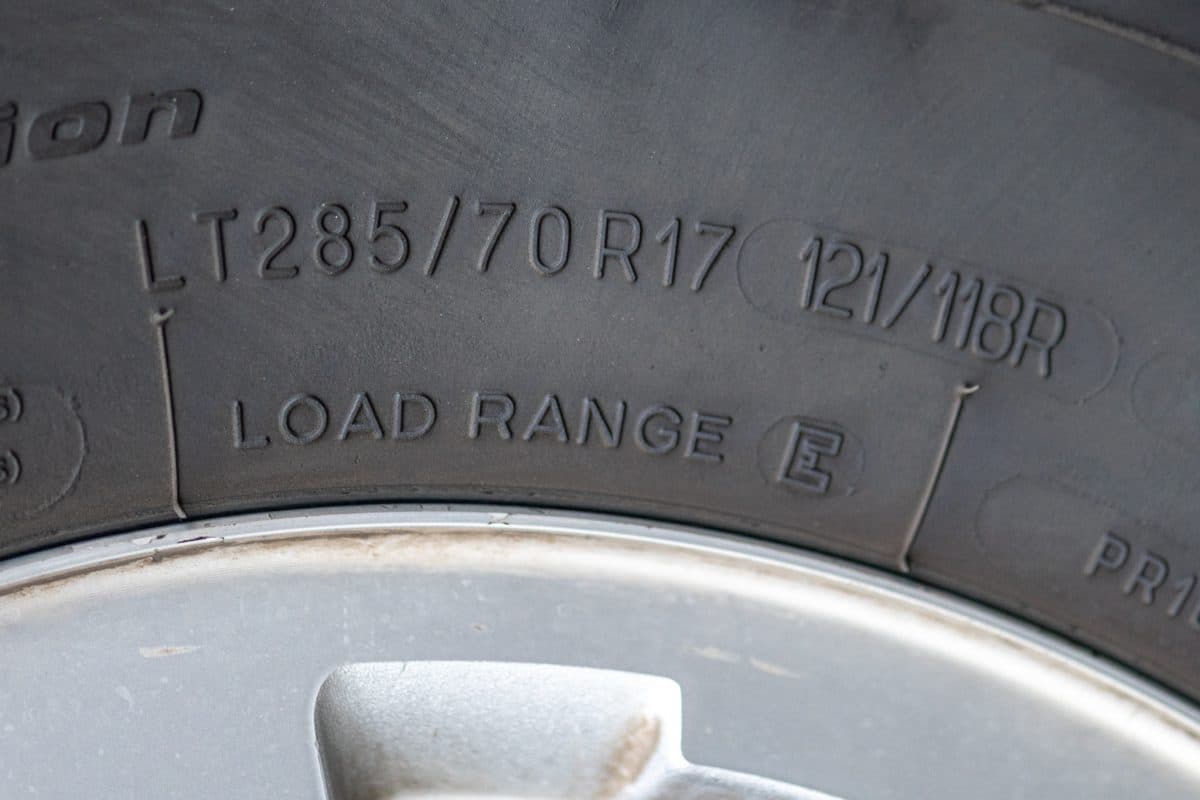
Load range refers to the older measurement standard of “PLY Rating.” This refers to the construct of the tire, which is made out of rubber and cord layers referred to as “plies.”
A “Load Range C” rating indicates the tire has a 6-ply equivalent load carrying capacity. A “D” tire has an 8-ply rating, and an “E” a 10-ply rating.
In the past, more plies indicated a tire had a larger load carrying capacity. Manufacturers would count a tire’s plies and use this number to denote carrying capacity. However, the modern construction of tires uses fewer piles without sacrificing the carrying capacity.
Modern load range markings simply tells how tough the tire is and the allowable PSI – pounds per square inch. For example, an “E” load range indicates that a tire is equivalent to a 10-ply construction tire. However, this tire is not built with 10 plies, but rather one or two plies of equivalent strength.
| Load Range | Ply Rating | Max Load Pressure |
| B | 4 | 35 PSI / 240 kPa |
| C | 6 | 50 PSI / 350 kPa |
| D | 8 | 65 PSI / 450 kPa |
| E | 10 | 80 PSI / 550 kPa |
| F | 10 | 95 PSI / 650 kPa |
Speed Rating
Another assigned number corresponding to the maximum speed the tire is expected to be able to sustain for prolonged periods. A speed rating of V indicates a speed of 149 miles per hour.
Tire Identification Number
The letters DOT preceding the number indicate that the tire meets all Federal standards as regulated by the Department of Transportation. The first two numbers or letters after the DOT indicate the plant where the tire was manufactured. The next four numbers indicate the date the tire was built, i.e., the number 1210 indicates that the tire was manufactured in the 12th week of 2010. These are the most important numbers in the TIN, as they are what the NHTSA uses to identify tires under recall for consumers. Any numbers after that are marketing codes used by the manufacturer.
Treadwear Indicators
These markings on the outer sidewall show when the tire has become legally bald.
Tire Ply Composition
The number of layers of rubber and fabric used in the tire. The more plies, the higher the load the tire can take. Also indicated are the materials used in the tire; steel, nylon, polyester, etc.
Treadwear Grade
In theory, the higher the number here, the longer the tread should last. In practice, the tire is tested for 8,000 miles and the manufacturer extrapolates tire wear compared to a baseline government test tire using whatever formula they prefer.
Traction Grade
Indicates the tire’s ability to stop on wet roads. AA is the highest grade, followed by A, B and C.
Temperature Grade
Indicates the tire’s resistance to heat buildup under proper inflation. Graded as A, B and C.
The treadwear, traction and temperature grades collectively make up the Uniform Tire Quality Grading (UTQG) standards, established by the National Highway Traffic Safety Administration.
Max Cold Inflation Limit
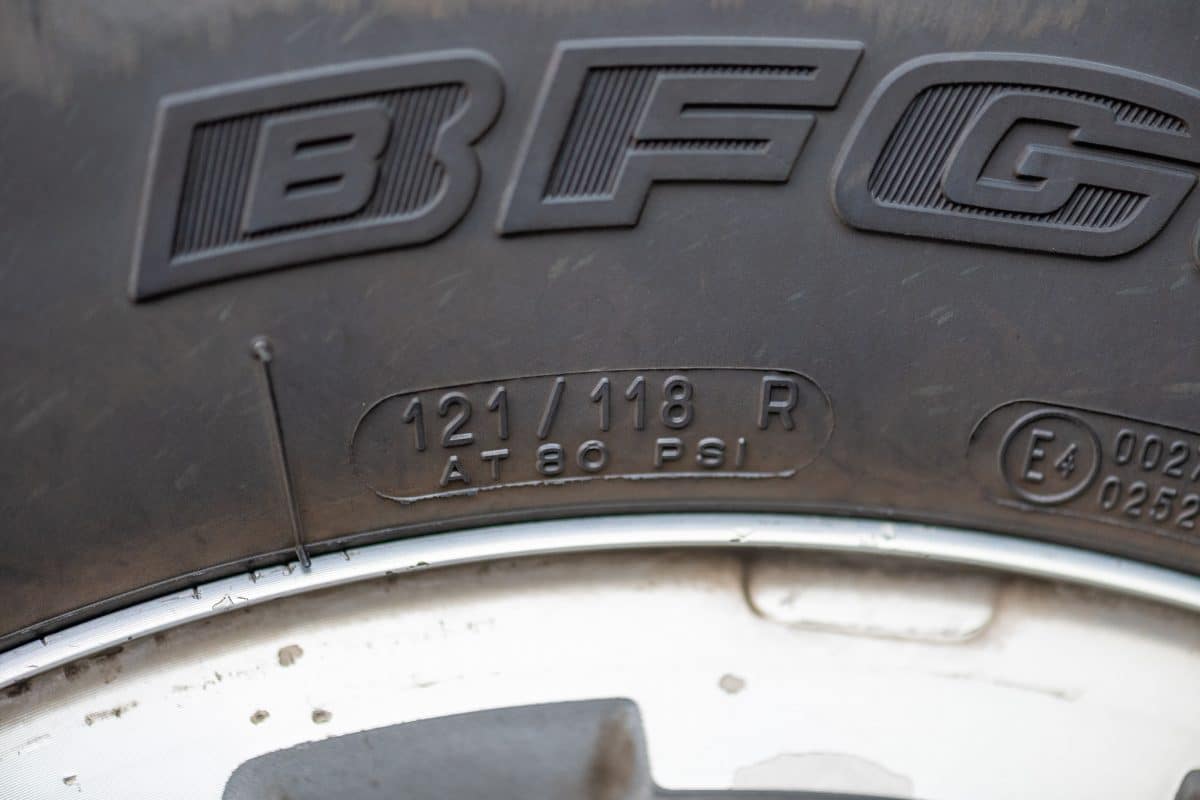
The maximum amount of air pressure the tire can hold. However, this number is misleading and should not be followed under most circumstances.
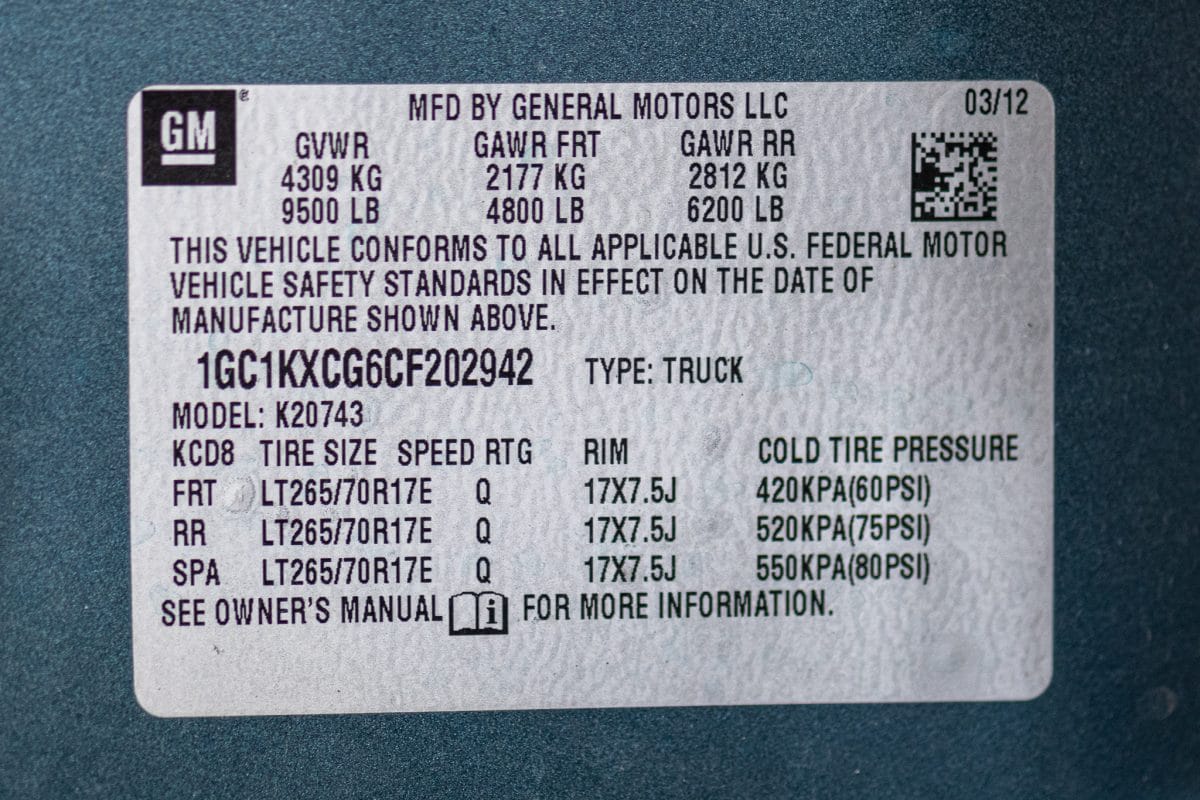
The proper inflation for your tires is printed on the driver’s side doorjamb. Inflation is measured in PSI (Pounds per square inch) and should always be measured when the tire is cold.
ECE Type Approval Mark
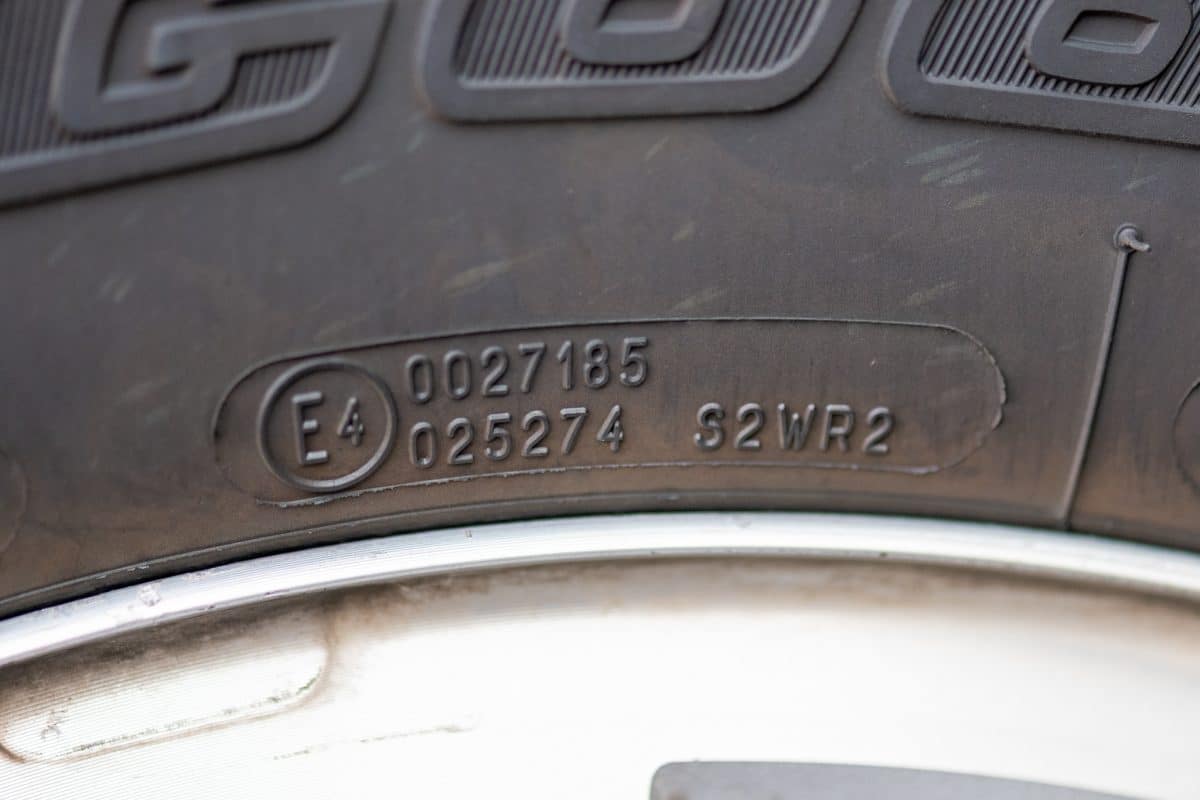
This indicates that the tire meets the standards of the Economic Commission for Europe.
The E-Mark is the regulations issued by the Economic Commission for Europe (referred to as ECE). E-Mark logo is placed in a circular frame. The number is the EU country or state number that granted approval. If one state grants approval, then it is considered sufficient for all other member states of the European Union.
The country/state codes are as follows: E1 – Germany, E2 – France, E3 – Italy, E4 – Netherlands, E5 – Sweden, E6 – Belgium, E7 – Hungary, E8 – Czech Republic, E9 – Spain, E10 – Yugoslavia, E11 – United Kingdom, E12 – Austria, E13 – Luxembourg, E14 – Switzerland, E16 – Norway, E17 – Finland, E18 – Denmark, E19 – Romania, E20 – Poland, E21 – Portugal, E22 – Russian Federation, E23 – Greece, E24 – Ireland, E25 – Croatia, E26 – Slovenia, E27 – Slovakia, E28 – Belarus, E29 – Estonia, E31 – Bosnia and Herzegovina, E32 – Latvia, E34 – Bulgaria, E37 – Turkey, E40 – Macedonia, E42 – European Community, E43 – Japan, E45 – Australia, E46 – Ukraine, E47 – South Africa.
The tire above was granted approval in the Netherlands.
The sister approval code is the EC safety certification mark, which is the same number in a rectangle frame.
M+S
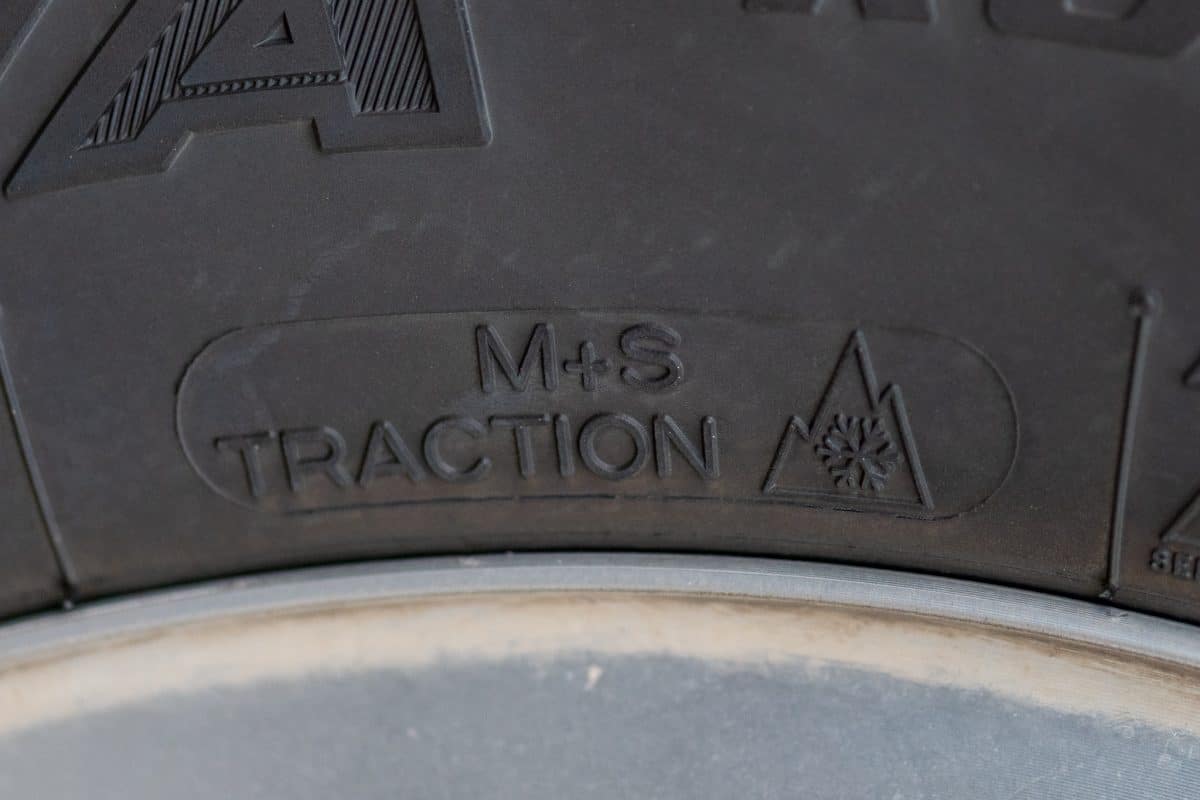
M+S indicates that the tire tread is capable of all-season compared to summer tires, which measures traction in mud and packed snow. It does not indicate traction on cold dry roads, slush, or ice. The rubber on the tires becomes hard under 40 degrees Fahrenheit, making the tires no longer safe.
Tires with a mountain and snowflake symbol indicate the tire meets more stringent requirements and is rated for severe snow service.
Also known as the ‘Mountain Snowflake Symbol’ because, well, it’s a picture of a snowflake superimposed on a mountain, this emblem indicates that the tire meets US and Canadian winter traction standards.
- About the Author
- Latest Posts
I strive to paint vivid landscapes with my words, bringing the magic of far-off lands and enchanting aromas to life for my readers. Combine passion for exploration and the art of gastronomy in an unending ode to the senses. When I’m not traversing the globe, I find solace in the earth beneath my fingertips, tending to my garden and working on projects around my verdant oasis. MK Library serves as a beacon, guiding fellow travelers and homebodies alike to embrace sustainability, nurturing both our planet and our souls with purpose. Full Bio.

